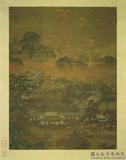明呂紀春風燕喜圖 軸
推薦分享
資源連結
連結到原始資料 (您即將開啟新視窗離開本站)後設資料
- 資料識別:
- 故畫002162N000000000
- 資料類型:
- 類型:繪畫
- 型式:靜態圖像
- 著作者:
- 呂紀
- 主題與關鍵字:
- 春景 燕 鴨.鳧 楊柳 萱花 江河、湖海
- 出版者:
- 數位化執行單位:國立故宮博物院
- 格式:
- 本幅 144.9x70.5公分、全幅 73公分
- 關聯:
- 石渠寶笈三編(延春閣),第四冊,頁1807&*故宮書畫錄(卷八),第四冊,頁77&*故宮書畫圖錄,第七冊,頁195-196 &* 呂紀(活動於西元一四七七-一四九七年間),浙江鄞縣人。字廷振,號樂愚,一作樂漁。花鳥初學邊文進,後摹唐宋諸名家筆,始臻其妙。弘治(西元一四八八-一五○五年)間被徵值仁智殿,為錦衣衛指揮使。 本幅畫溪岸柳樹下,萱花盛開;一雙飛燕臨空掠過,岸上則止息瀆鳧一對。其中柳樹幹之皴法,以及萱花、柳葉與雙鳧之鉤畫用筆,甚得呂紀之筆意,若自神韻觀之,則仍顯得略遜一籌。 &* Lü Chi, style name T’ing-chen, sobriquet Yao-yü, was a native of Yin County, Chekiang. In the genre of flower and bird painting, Lü initially studied the works of the early Ming dynasty painter, Pien Wen-chin. He later emulated the works of the T’ang (618-907) and the Sung (960-1279) masters. He eventually became one of the greatest painters of birds and flowers of the Ming dynasty. During the Hung-chih era (1488-1505), he was summoned to serve in the Hall of Benevolent Wisdom (Jen-chih Tien) in the imperial court. Lü served as a commander in the Imperial Bodyguard, a military unit that also provided sinecures for court painters. On the bank of a stream, day lilies bloom under a willow tree. Two ducks rest by the willow while a pair of swallows fly around above. The texture strokes on the trunk of the willow as well as the outlining method and brushwork in the lilies, willow leaves, and ducks all seem to have the feel of Lü Chi’s brush method but lack his grace and spirit.
- 管理權:
- 國立故宮博物院
授權聯絡窗口
- 國立故宮博物院圖像授權、出版授權、影音資料授權-申請流程說明
http://www.npm.gov.tw/zh-TW/Article.aspx?sNo=03003061






